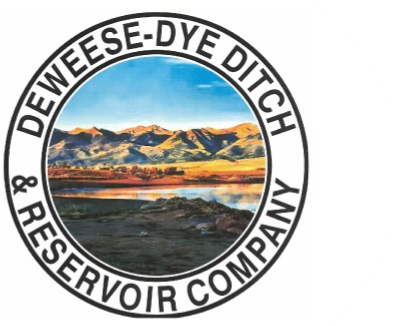Where Does your Water Come From
and How Does it Get to You
Water for the DeWeese-Dye Ditch and Reservoir Company comes from the Grape Creek drainage southwest of Canon City. We also store water for our use in DeWeese Reservoir. The diversion on Grape Creek directs the water into our system where it flows about seven miles in open ditch, pipes, tunnels and siphons into three small reservoirs located in Lincoln Park. The main ditch feeds different areas each day and in the evening the water is directed back to the reservoirs and the cycle begins again. People who wonder why we are running water while it is raining don’t realize the water travels 36 miles making it impossible to turn it on and off with the weather.
We are allowed to store water from November 15 to March 15 each year under a Winter Water Storage Agreement. Under this program we can close our headgate and store all of the water coming down Grape Creek from November 15 to March 15. Without this agreement, we could not store unless the call on the river was over 1901. Our shareholders should understand the benefit we receive from the program and recognize without this agreement; there would be winters when we could store very little water.
The Colorado Game and Fish Department bought a 500 acre foot conservation pool which remains in the reservoir at all times. This water is unusable for irrigation because of the mud level.
358 Acre feet of storage space was purchase by Round Mountain Water District to compensate for the water they are removing from the creek through their wells. Their purchased water is stored in the reservoir and is released by the Water Commissioner during the year, making up for the water that Round Mountain does not return to the creek.
Normally, if the Arkansas River call is November 23, 1894 or later we are allowed to take water directly from Grape Creek without using any of our stored water from the reservoir. After Spring runoffs end and there are calls on the river, water is released from the reservoir to help fill our ditch. We can then take about 40% (10.75 cfs) of our water directly from the creek with the direct flow rights we own on Grape Creek and the water we have stored in DeWeese Reservoir supplies the other 60% (15 to16 cfs) to fill our ditch to the 26 cubic feet of water per second (cfs) during the irrigation season. In a normal year you should get water twice a week.
In a dry year when the stream flow drops and will not provide the 10 cfs, we have to increase the amount of water released from the reservoir in order to fill our ditch. Under drought conditions when the creek does not supply the 10 cfs, the Board of Directors has the responsibility to the reduce the water to once a week in order to make the water last as long as possible. When this happens we implement a one day a week water policy.
W2250 Winter Storage Program
Historically the large canals east of Pueblo consistently stored and irrigated throughout the winter season. In spite of the difficulties involved, winter irrigation was found to be beneficial towards maintaining soil moisture for the next season’s crop. Ultimately it was determined that the same or greater benefit could be derived by storing these same waters during the winter and having this additional water available during the summer irrigation season.
The design of the Fryingpan-Arkansas Project included Pueblo Reservoir as its principal regulating reservoir. Pueblo Reservoir was designed to have sufficient storage space to allow for the storage of these winter waters.
Following completion of Pueblo Reservoir in the 1970’s the canal companies East of Pueblo began a winter storage program instead of the historic practice of direct winter irrigation. Each company was allocated a certain percentage of total diversions to storage from the river. In 1990 this “Winter Water Storage Program” was finally decreed by the Water Court. One of the things this decree required was a fixed call date for water on the river of March 1, 1910.
Historically the call during the earlier periods of winter irrigation was typically anywhere from 1884-1906.
The Colorado Canal Company was often one of these calling water rights with a 1890 call date.
This more junior 1910 fixed call would allow upstream junior storage rights to store more water than historically occurred or was allowed. This would include the 1901 storage right for DeWeese Reservoir.
In exchange for this greater opportunity to store water these upstream storage entities agreed to pay back to the Colorado Canal Company a total of 2,250 acre-feet of the total amount of water that these upstream entities stored each season.
This 2,250 acre-foot repayment amount is divided proportionally between the upstream entities relative to the amount of water each entity stored that winter. This 2,250 acre-foot repayment is typically released or traded to the Colorado Canal Company following the winter storage season in March or April by each upstream entity.

